TLR Design Heritage
Contents
(Scroll down or click on links)
The Rolleicord DNA
Recipe for Success
The Rollei Comparison - Can Yashima Match Franke & Heidecke?
The Rolleicord DNA
It is interesting that not only the general design and layout but the body casting in particular of the original Pigeonflex was very similar to both the Rolleicord models of 1936 to 1938 and to other Rollei clones from post-War startups at the time e.g., Cosmoflex, Nikkenflex, Malcaflex, Manonflex and others. I have seen at least two Yashicaflex Cs for sale on Yahoo Japan fitted with a perfectly natural looking backs similar to those commonly found on some Tōkyō Kōgaku, or Tokyo Optical Co., (later Topcon) made Laurelflex and Primoflex models - obviously the designs, dimensions and tolerances were very close. The smaller companies were more likely to have started as assemblers of parts than designers and manufacturers - how the early Yashica fits into this spectrum is not known. The more established brands often showed more individuality and innovation but the clear link to Franke & Heidecke design was common to all.
It would be a mistake to think that copying was a post-War phenomenon. Pre-War and early War TLR models were much more likely to be a carbon copy of a Rolleicord down to trim and feature-set, some perhaps introduced as the originals became difficult to obtain.
1953 Yashima Pigeonflex on left, right image is of a pre-War Rolleicord II. Note the body casting detail - early Rolleicord type for both. The nameplate with underlined name channeled the later Rolleicords.
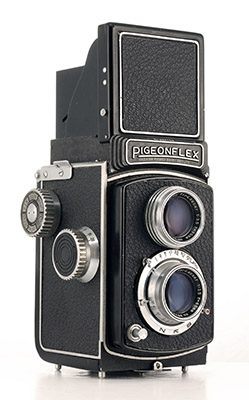
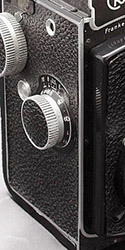
(Left image courtesy of Tom Heckhaus, right, detail from larger web image)
By the early 1950s, some Japanese TLRs were already based more on the 1940's Rolleicord type bodies (the differences were mainly cosmetic around the focusing lens board panel surround) and the remaining makers, including Yashima, seemed to move to the newer design as one (see “Bodies & Trim”). Below left is a later Rolleicord II from probably the early 1940s with the newer style casting which Yashima adopted in 1955. The first Yashima models didn't include some of the contemporary Rolleicord's more advanced and costly features such as the auto-stop film wind with film counter and Bay 1 lens mounts, even though auto-stop film winding had been common on pre-War Japanese clones. The 1955 Yashicaflex C on the right has these features already (plus also the sports viewfinder and flash sync which first appeared on Rolleicord III models in 1950 and an accessory shoe which is missing from all Rolleicord models).
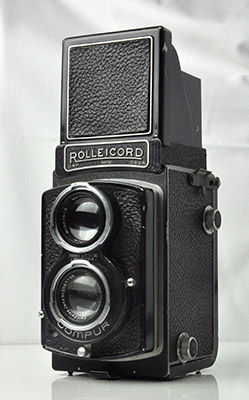
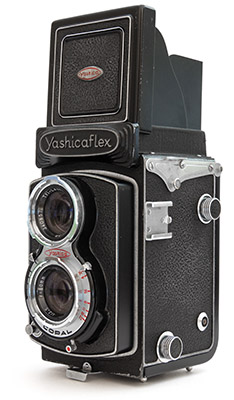
(Left image courtesy of Göran Årelind)
The copying of Franke & Heidecke TLRs was more than skin deep. Below are film spool knob side castings and mechanisms from both makers:
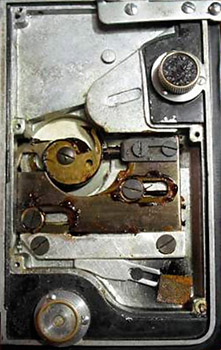
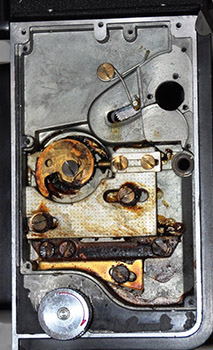
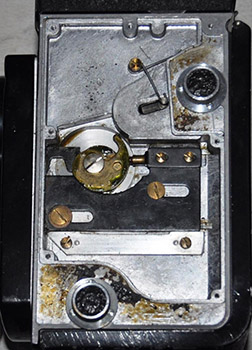
(Image 1 is detail from larger web image, images 2 and 3 courtesy of Göran Årelind)
Image 1 is a 1953 Yashima Pigeonflex with early body. Image 2 is a post-1958 Yashica 635 with late body. Image 3 is a 1940s Rolleicord II with late body. Pretty much everything looks the same and fits in the same place in all three cameras. The only significant differences are that the Pigeonflex doesn't have the spring and other parts associated with the film counter shaft even though the casting makes provision for it (slot left of top spool knob), the Yashica cameras have an additional part at the bottom to assist with the focus mechanism adjustment (there on later Rolleis, presumably from before 1953 and copied by Yashima) and the 635 has a hole for the 35 mm rewind release (middle of the right edge). The Rolleiflex shows a similar heritage to the Rolleicord but it's castings are more complex and the mechanisms, although operating in a similar way, are more refined. In comparison, the Yashica-Mat is virtually identical to the Yashica 635 except that the focus shaft is extended for mounting the focusing knob on the spool knob side (in place of the retaining screw for the brass focusing cam in the centre).
In that context, it is important to appreciate that the Rolleiflex is a more expensive and sophisticated professional tool than the Rolleicord. The Yashica crank wind models, starting with the Yashica-Mat, may bear a passing resemblance to the Rolleiflex and operate in a similar way but in reality, they are typical Yashica 66 models with the crank wind adaptation bolted on. Mechanically, the most generous comparison to a Franke & Heidecke model would be to think of them as crank wind Rolleicords.
Superficially, the Yashica-Mat gear train on the left seems to replicate the early Rolleiflex on the right quite closely (later Rolleiflex models are very similar). Rather than re-inventing the wheel, Yashima took a proven design and adapted it for low cost mass production. It's not a Rolleiflex competitor in the sense that most people buying a Yashica-Mat couldn't afford a Rollei even if they wanted one and the people buying a Rolleiflex were either well-heeled enthusiasts or already successful professionals needing a robust and reliable tool.
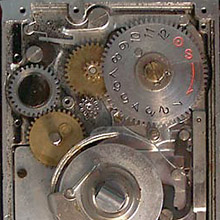
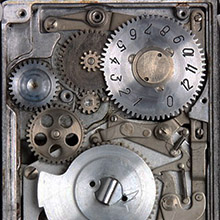 (Detail from larger web images)
(Detail from larger web images)
The differences between the two can be summed up by that well-used saying, “the devil is in the detail”. The Yashica's pressed metal linkages appear simpler, thinner and with more basic pivot points. The soft brass intermediate gears are cheaper to produce and machine and don't require as-close tolerances to mesh smoothly with harder metal components. The downsides are that larger tolerances reduce smoothness, increase noise and the soft brass wears quicker. For its intended market, the Yashica-Mat was perfectly adequate, even for light professional use. We are talking about degrees here, not night and day differences.
Recipe for Success
The established Japanese camera makers like Minolta, Ricoh (later), Olympus, Fujica, Mamiya, even new maker Kowa with its sophisticated Kalloflex and possibly others such as early maker Elmo, arguably produced some more sophisticated TLR products with more highly regarded optics (although the Lumaxars and Yashinons are very good) but what made Yashica successful was excellent value for money helped by using the same effective and reliable basic body structure to plug every possible price point in the market. Features and specifications varied between models but there is no evidence that there was additional cost cutting with the more basic ones. The period articles referred to earlier confirm Yashica's commitment to value for money and good quality to be achieved through automation and high volumes. Also, there appears to have been a clear recognition of the importance of understanding the mass-market customer.
Below is a table of early 1950s prices for Japanese TLRs compiled from www.tlr66.com and other sources. It seems that in the beginning, the quite ordinary specification-wise Pigeonflex, Yashima Flex and Yashica Flex B were priced at a level commensurate with their features and similar to equivalent competing products. The exposure meter and other specs improvements of the Yashicaflex S placed it at a reasonable premium above the others. However, by late 1954 with the release of the Yashicaflex A-II, the value for money approach was quite noticeable and the 1955 Yashicaflex C was remarkably affordable for its specs and quality. In the meantime, Endō Sashin Yōhin had not altered either the price or basic specs of the Pigeonflex models it sold. The Yashicaflex C offered a higher shutter speed, auto-stop winding, Bay 1 filter mounts and probably better lenses, all for 3,500 yen less. It should also be noted that quite a few of the competitors' models at the bottom end, including the Hobiflex III, Amiflex, Silverflex and Richoflex VII listed in the table, had cheap pressed metal bodies and simple geared together lenses with helical focusing.
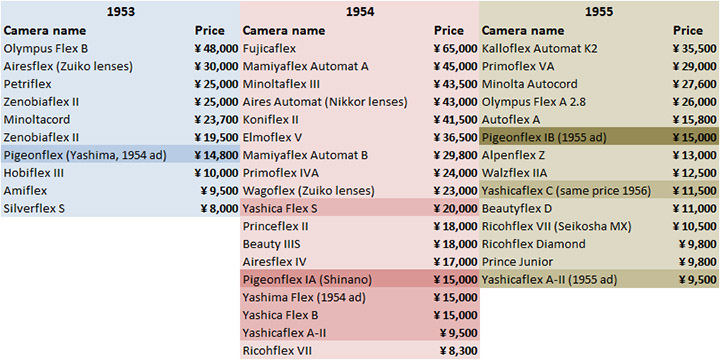
Brochures and catalogues from the late 1950s continue to show a considerable price differential in favour of Yashica cameras against the “old order”. For example, the 1960 Olden Camera and Lens Company catalogue lists the top of the line Yashica-Mat at US$75.50 and the Minolta Autocord (without meter) for US$99.50. The difference in quality was almost certainly much less than the price differential suggested. Also, at the lower end, Minolta had already abandoned the knob-wind market by the mid-1950s. The Yashica value proposition was often emphasised in early marketing material in Japan and then in the US, particularly with the release of the Yashica A, C and LM trio in 1956 and the Yashica-Mat in 1957 but also throughout TLR production.
Having taken the value for money route also ensured that there were neither the resources nor culture for engaging in expensive research and development activities and no room to make extensive or costly changes to components. The inspired grafting of a Sekonic CB-1 exposure meter to the side of something which was still 85% Pigeonflex is by far the most innovative piece of design that Yashima/Yashica ever attempted with its TLRs. Elegant it wasn't but the Yashica Flex model S certainly got them noticed, and then the market rewarded the company for its conservative, cost conscious approach. The evidence also seems to be that quality levels were more than satisfactory. In other words, consumers were happy to pay for what they were getting.
The Rollei Comparison - Can Yashima Match Franke & Heidecke?
Inevitably, comparisons are also made with comparable Rolleiflex and Rolleicord models. Certainly the photographic concept is the same and the Yashicas have a strong design and functional relationship to the earlier Rollei models. Is the comparison favourable? Of course not! In regard to crank wind comparisons, I have already partly answered that above. Webb's Photographic Gift Guide (c1964) lists the then top of the line Yashica Mat-EM at “less than” US$85, the Minolta Autocord at US$109.45 and the Rolleiflex 3.5F at US$299.50. If more than three times the price did not buy better lenses, more reliable mechanics with a better precision feel and consistently excellent quality, then Rollei would not have sold many cameras at all. What is surprising is that for amateur use, the Yashicas weren't that far from the Rolleiflex experience but for professional use, their crank wind mechanisms were perhaps too fragile.
The differences were less between knob wind models, although the Rolleicord V upped the sophistication levels somewhat and the Tessar type Xenar lens became standard on Rolleicords before Yashima made its first Pigeonflex. It all depends on which models are being compared.
There is probably not a lot to choose between the Tomioka triplets, especially the Yashikor, and the similar but earlier Zeiss Triotar. Whilst Yashica's Tessar lens designs (Lumaxar 75 mm and 80 mm and Yashinon) were respectable, they couldn't match the Rolleis in either choice or sophistication (Zeiss Tessar and the equivalent Schneider Xenar and the more complex Zeiss Planar and Schneider Xenotar in both f/3.5 and f/2.8 forms) but again, the real world differences were not as great as maybe expected and even less when stopped down.